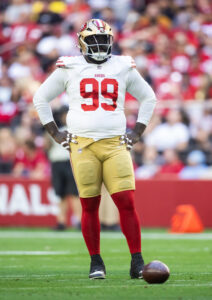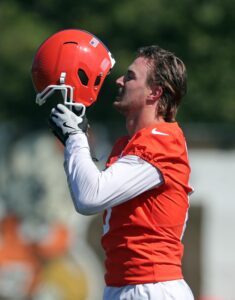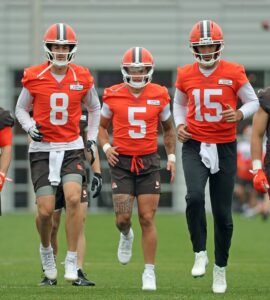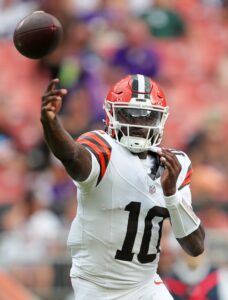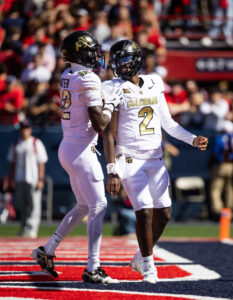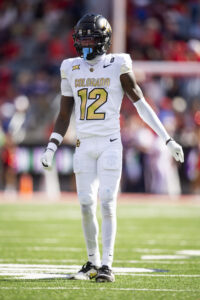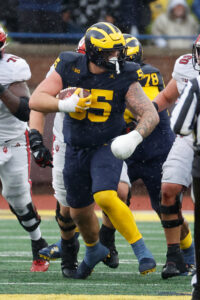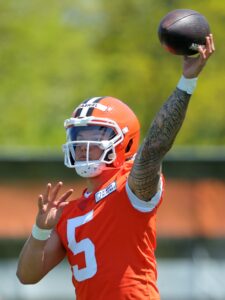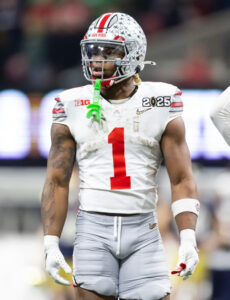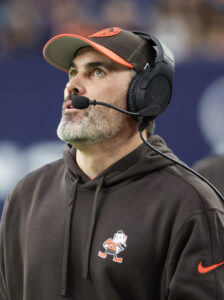Poll: Who Fared Best At Trade Deadline?
The NFL’s latest trade deadline featured eight Tuesday trades, but a total of 22 in-season swaps occurred this year. Some teams made multiple trades; several others stood pat. Two of the biggest trades in deadline history went down this week.
 While not quite on the Herschel Walker/Eric Dickerson level, the Sauce Gardner blockbuster rivaled the Rams’ Jalen Ramsey addition from 2019. Like the Ramsey exchange, the Gardner value brought two first-rounders and another asset (wide receiver Adonai Mitchell, in this case) for a 25-year-old All-Pro cornerback. Barely an hour later, the Jets followed through with a teardown by sending Quinnen Williams to the Cowboys for first- and second-round picks and defensive tackle Mazi Smith.
While not quite on the Herschel Walker/Eric Dickerson level, the Sauce Gardner blockbuster rivaled the Rams’ Jalen Ramsey addition from 2019. Like the Ramsey exchange, the Gardner value brought two first-rounders and another asset (wide receiver Adonai Mitchell, in this case) for a 25-year-old All-Pro cornerback. Barely an hour later, the Jets followed through with a teardown by sending Quinnen Williams to the Cowboys for first- and second-round picks and defensive tackle Mazi Smith.
As we detailed Wednesday in the latest Trade Rumors Front Office post, the Jets’ perspective brought strong value for young players toiling on a downtrodden team. The three first-rounders plus the 2026 second will give New York’s new decision-makers a chance to retool while having assets to either find a quarterback in the draft or trade for a veteran. While it will be difficult to replace Gardner and Williams, the Jets’ Darren Mougey-Aaron Glenn regime made the decision to cash in their top assets to launch a true rebuild — one that suddenly features plenty of QB ammo.
From the Colts’ perspective, Gardner brings an accomplished starter at a young age. Indianapolis received a player signed through 2030, though New York’s contract structure on the July extension limited the Gardner dead money to $19.75MM — far less than the Dolphins just took on for Ramsey or what the Saints absorbed upon trading Marshon Lattimore last year.
The Colts, after building from within for years, now have three high-cost DB contracts added this year in the Gardner accord and those given to Charvarius Ward and Camryn Bynum. Tied for the best record in the AFC (at 7-2), the Colts made a move and watched the Patriots, Broncos, Bills and Chiefs hold off on buyer’s trades.
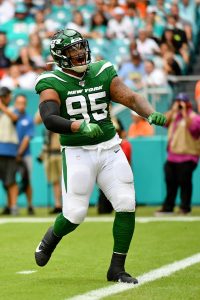 Dallas’ stance is a bit more complicated. The Cowboys went from trading Micah Parsons for two first-rounders ahead of his age-26 season to acquiring Williams, who will turn 28 in December. The team still has three first-round picks between 2026 and ’27, but sending the higher-value ’27 first to the Jets strips away a prime asset for a player not on Parsons’ level.
Dallas’ stance is a bit more complicated. The Cowboys went from trading Micah Parsons for two first-rounders ahead of his age-26 season to acquiring Williams, who will turn 28 in December. The team still has three first-round picks between 2026 and ’27, but sending the higher-value ’27 first to the Jets strips away a prime asset for a player not on Parsons’ level.
Jerry Jones harped on the team’s run defense upon acquiring Kenny Clark in the Parsons trade, but that unit has faceplanted this season. Williams joins Clark and Osa Odighizuwa in a suddenly pricey Dallas D-tackle corps, and the longtime Jet had angled for a contract rework — something the Cowboys may now have to navigate.
The Cowboys also added Logan Wilson, after trying to grab Quincy Williams from the Jets in a two-brother trade, but the younger Williams brother represents the obvious talking point here. Dallas’ interior D-line is well stocked. Will Quinnen Williams help transform a sub-.500 Cowboys team in the way Amari Cooper did after the team surrendered a first at the 2018 deadline?
Deadline day also brought two wide receiver moves. The two wideouts most likely to be traded were, in fact, dealt. The Jaguars gave up fourth- and sixth-round picks for the Raiders’ Jakobi Meyers, a deal that may have crystalized the Rashid Shaheed market. Shaheed cost the Seahawks fourth- and fifth-round choices.
 Meyers will help the Jags replace Travis Hunter and provide some stability in a receiving corps also dealing with a Brian Thomas Jr. injury. Shaheed joins a surging Seattle squad, reuniting with 2024 New Orleans OC Klint Kubiak, and will be an interesting complementary piece for All-Pro candidate Jaxon Smith-Njigba. With Smith-Njigba, Shaheed, Cooper Kupp and rookie Tory Horton, the Seahawks look to have one of the NFL’s best receiving cadres.
Meyers will help the Jags replace Travis Hunter and provide some stability in a receiving corps also dealing with a Brian Thomas Jr. injury. Shaheed joins a surging Seattle squad, reuniting with 2024 New Orleans OC Klint Kubiak, and will be an interesting complementary piece for All-Pro candidate Jaxon Smith-Njigba. With Smith-Njigba, Shaheed, Cooper Kupp and rookie Tory Horton, the Seahawks look to have one of the NFL’s best receiving cadres.
Jacksonville also engaged in a cornerback swap, prying contract-year cover man Greg Newsome from the Browns in October. Newsome has started two games with the Jags and has incentive to perform well this season, as he is uncontracted for 2026. Tyson Campbell is signed through 2028, giving the Browns some cost certainty — albeit now carrying two upper-crust CB contracts, along with Denzel Ward‘s — at a premium position.
Cleveland did not aggressively sell, keeping its guards, David Njoku and other rumored trade assets, though they did do Joe Flacco a solid — to Mike Tomlin‘s chagrin — by trading the demoted QB within the division. Flacco immediately became the Bengals’ starter and has rejuvenated Cincy’s offense.
The Jags also collected fifth- and sixth-round picks from the deadline’s top buyer. The trade-happy Eagles finished their 2025 by making 12 trades (excluding pick-for-pick transactions). In-season, Philadelphia made four. Following the Bigsby move, the defending champs acquired cornerbacks Michael Carter II and Jaire Alexander during their bye week, before sending the Dolphins a third-rounder for Jaelan Phillips. Philly now has Brandon Graham and Phillips in an edge-rushing corps housing Nolan Smith and Jalyx Hunt. Carter and Alexander provide potentially better answers compared to Adoree’ Jackson and Kelee Ringo alongside Quinyon Mitchell and Cooper DeJean.
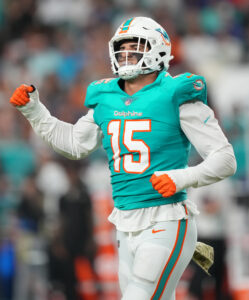 The Rams quietly bolstered their CB contingent by obtaining Titans contract-year slot player Roger McCreary, while Tennessee also sent Dre’Mont Jones to Baltimore. The Ravens added Jones and Alohi Gilman, the latter becoming an immediate starter and helping maximize All-Pro Kyle Hamilton. Jones, who has 4.5 sacks this season, replaces Odafe Oweh — traded to the Chargers in the Gilman swap — in Baltimore’s OLB rotation. A former 3-4 defensive end, Jones gives Baltimore some pass rush options after Gilman supplied them with a deep safety. Gilman is also in a contract year.
The Rams quietly bolstered their CB contingent by obtaining Titans contract-year slot player Roger McCreary, while Tennessee also sent Dre’Mont Jones to Baltimore. The Ravens added Jones and Alohi Gilman, the latter becoming an immediate starter and helping maximize All-Pro Kyle Hamilton. Jones, who has 4.5 sacks this season, replaces Odafe Oweh — traded to the Chargers in the Gilman swap — in Baltimore’s OLB rotation. A former 3-4 defensive end, Jones gives Baltimore some pass rush options after Gilman supplied them with a deep safety. Gilman is also in a contract year.
While the Dolphins did not dive into full sales mode, retaining Jaylen Waddle and Bradley Chubb, after parting with longtime GM Chris Grier, they did obtain a third-round pick for Phillips — who is in his fifth-year option season. The Chargers also added two more trades before the 3pm buzzer Tuesday, most notably adding Trevor Penning — a three-position starter for the Saints — for a late 2027 draft choice. A contract-year blocker, Penning will be an option for a battered Bolts’ tackle corps.
The Steelers’ long-rumored wide receiver quest did not lead to a deal, but the team did add veteran safety Kyle Dugger, who had fallen out of favor with the Patriots despite signing an eight-figure-per-year extension as a transition-tagged player in 2024.
Who do you think did the best job at this year’s deadline? Vote in PFR’s latest poll and weigh in with your thoughts in the comments section.
2025 NFL Trades
The modern NFL features four clear trade windows. While the Cowboys and Steelers’ George Pickens swap showed moves can be made at other points on the NFL calendar, early March, the draft, the late-August 53-man roster-setting date and the November deadline reside as the primary points trades occur around the league. On that note, it is a good time to check in on what has transpired on the trade market ahead of today’s deadline.
Excluding pick-for-pick trades, here are the moves NFL teams have made thus far in 2025:
March 1
- Commanders acquire WR Deebo Samuel from 49ers for No. 147
49ers chose running back Jordan James at 147
March 4
- Bears obtain G Jonah Jackson from Rams for No. 202
Rams traded pick to Vikings, moving up to No. 172 for linebacker Chris Paul Jr.
March 5
- Bears form new guard duo, acquiring Joe Thuney from Chiefs for 2026 fourth-round pick
March 6
- Intra-AFC South swap sends Texans Christian Kirk, Jaguars 2026 seventh-round pick
March 7
- Pete Carroll–Geno Smith reunion sends No. 92 from Raiders to Seahawks
Seahawks chose quarterback Jalen Milroe at 92
March 9
- Steelers acquire WR D.K. Metcalf, No. 185 from Seahawks in exchange for Nos. 52, 223
Seahawks used No. 52 to trade up (via the Titans) 17 spots for safety Nick Emmanwori, drafted running back Damien Martinez at 223; Steelers selected quarterback Will Howard at 185
March 10
- Saints land DT Davon Godchaux from Patriots for 2026 seventh-round pick
- Commanders add LT Laremy Tunsil, No. 128 from Texans for Nos. 79, 236, along with 2026 second-, fourth-round picks
Texans added wide receiver Jaylin Noel at 79, sent 236 to Jaguars in Day 2 trade; Commanders chose wideout Jaylin Lane at No. 128
- Browns acquire QB Kenny Pickett from Eagles for QB Dorian Thompson-Robinson, No. 164
Eagles used No. 164 to climb one spot (via Chiefs) in first round for linebacker Jihaad Campbell
March 11
- Texans bring in S C.J. Gardner-Johnson, 2026 sixth-round pick from Eagles for G Kenyon Green, 2026 fifth-rounder
March 12
- Cowboys obtain CB Kaiir Elam, No. 204 from Bills in exchange for No. 170, 2026 seventh-round choice
Bills took Ohio State cornerback Jordan Hancock at 170; Cowboys chose guard Ajani Cornelius at No. 204
- Cowboys acquire LB Kenneth Murray, No. 239 from Titans for No. 188
Titans drafted running back Kalel Mullings at No. 188; Cowboys chose running back Phil Mafah at 239
March 13
- Texans add G Ed Ingram from Vikings in exchange for 2026 sixth-round pick
March 15
- Vikings acquire RB Jordan Mason, No. 187 from 49ers for No. 160, 2026 sixth-round pick
Vikings packaged No. 187 in trade-down move (via Texans); 49ers drafted safety Marques Sigle at 160
April 3
- Cowboys obtain QB Joe Milton, No. 217 from Patriots in exchange for No. 171
Patriots traded down from No. 171 (via Lions) to draft kicker Andres Borregales; Cowboys chose defensive tackle Jay Toia at 217
April 26
- Vikings acquire QB Sam Howell, No. 172 from Seahawks in exchange for 142
Seahawks selected defensive lineman Rylie Mills at No. 142; Vikings traded No. 172 to Rams
May 7
- Cowboys add WR George Pickens, 2027 sixth-round pick from Steelers for 2026 third-round pick, 2027 fifth-rounder
June 2
- 49ers land DE Bryce Huff from Eagles in exchange for conditional 2026 fifth-round pick
Pick could upgrade to fourth-rounder if performance-based conditions are met
June 30
- Steelers add CB Jalen Ramsey, TE Jonnu Smith, 2027 seventh-round pick from Dolphins for S Minkah Fitzpatrick, 2027 fifth -round pick
July 1
- Dolphins to acquire TE Darren Waller, conditional 2027 seventh-round pick from Giants in exchange for 2026 sixth-rounder
August 4
- Eagles to acquire CB Jakorian Bennett from Raiders in exchange for DT Thomas Booker
August 17
- Eagles land WR John Metchie, 2025 fifth-round pick from Texans in exchange for TE Harrison Bryant, 2026 sixth-rounder
- Saints acquire C Luke Fortner from Jaguars in exchange for DL Khalen Saunders
August 20
- Jets add DT Jowon Briggs, 2026 seventh-round pick from Browns for 2026 sixth-rounder
- Jets obtain DL Harrison Phillips, 2027 seventh-round pick from Vikings for 2026, 2027 sixth-rounders
- Saints land WR Devaughn Vele from Broncos for 2026 fourth-round pick, 2027 seventh-rounder
- 49ers acquire WR Skyy Moore, 2027 seventh-round pick from Chiefs for 2027 sixth-rounder
August 22
- 49ers bring in RB Brian Robinson from Commanders in exchange for conditional 2026 sixth-round pick
August 24
- Eagles acquire QB Sam Howell, 2026 sixth-round pick from Vikings for 2026 fifth-rounder, 2027 seventh
- Chiefs add DT Derrick Nnadi, conditional 2027 seventh-round from Jets for conditional 2027 sixth-rounder
- Eagles bring back T Fred Johnson from Jaguars in exchange for 2026 seventh-round pick
- Packers obtain OL Darian Kinnard from Eagles for 2027 sixth-round pick
August 25
- Raiders acquire QB Kenny Pickett from Browns for 2026 fifth-round pick
- Colts add CB Mekhi Blackmon from Vikings for 2026 sixth-round pick
August 26
- Browns acquire T KT Leveston from Rams for 2028 seventh-round pick
- Falcons add T Michael Jerrell from Seahawks for conditional 2027 seventh-round pick
- Saints bring in T Asim Richards, 2028 seventh-round pick from Cowboys for 2028 sixth-rounder
- Chargers acquire T Austin Deculus from Texans in exchange for conditional 2027 seventh-round pick
August 27
- Jaguars obtain WR Tim Patrick from Lions for 2026 sixth-round pick
- Vikings land WR Adam Thielen, conditional 2026 seventh-round pick, 2027 fifth-rounder from Panthers for 2026 fifth-round choice, 2027 fourth
August 28
- Packers acquire DE Micah Parsons from Cowboys for DT Kenny Clark, 2026, 2027 first-round picks
September 8
- Eagles add RB Tank Bigsby from Jaguars in exchange for 2026 fifth-, sixth-round picks
2026 fifth-round pick (from Bryce Huff trade) could upgrade to fourth-rounder, which would be sent to Jacksonville if 49ers DE meets those conditions
September 14
- Saints obtain WR Ja’Lynn Polk, 2028 seventh-round pick from Patriots for 2027 sixth-rounder
September 23
- Jets acquire CB Jarvis Brownlee, 2026 seventh-round pick from Titans for 2026 sixth-rounder
September 29
- Browns add LT Cam Robinson, 2027 seventh-round pick from Texans for 2027 sixth-rounder
October 7
- Bengals obtain QB Joe Flacco, 2026 sixth-round pick from Browns for 2026 fifth-rounder
- Chargers land OLB Odafe Oweh, 2027 seventh-round pick from Ravens for S Alohi Gilman, 2026 fifth-rounder
October 8
- Browns acquire CB Tyson Campbell, 2026 seventh-round pick from Jaguars for CB Greg Newsome, 2026 sixth-rounder
October 27
- Rams add CB Roger McCreary, 2026 sixth-round pick from Titans for 2026 fifth-rounder
October 28
- 49ers bring in DE Keion White, 2026 seventh-round pick from Patriots for 2026 sixth-rounder
- Steelers acquire S Kyle Dugger, 2026 seventh-round pick from Patriots for 2026 sixth
October 29
- Eagles add CB Michael Carter II, 2027 seventh-round pick from Jets for WR John Metchie, 2027 sixth-rounder
November 1
- Eagles acquire CB Jaire Alexander, 2027 seventh-round pick from Ravens for 2026 sixth-rounder
November 3
- Eagles obtain OLB Jaelan Phillips from Dolphins in exchange for 2026 third-round pick
- Ravens land OLB Dre’Mont Jones from Titans for conditional fifth-round pick
November 4
- Cowboys acquire LB Logan Wilson from Bengals for 2026 seventh-round pick
- Jaguars bring in WR Jakobi Meyers, sending 2026 fourth-, sixth-round picks to Raiders
- Colts obtain CB Sauce Gardner from Jets, who collect WR Adonai Mitchell, 2026, 2027 first-round picks
- Seahawks add WR Rashid Shaheed from Saints for 2026 fourth-, fifth-round picks
- Bears acquire DE Joe Tryon-Shoyinka, 2026 seventh-round pick from Browns for 2026 sixth-rounder
- Cowboys land DT Quinnen Williams from Jets for DT Mazi Smith, 2026 second-round pick, 2027 first-rounder
Higher of Cowboys’ two 2027 firsts will go to Jets in Williams trade
- Chargers add OL Trevor Penning from Saints in exchange for 2027 seventh-round pick
- Jets acquire CB Ja’Sir Taylor from Chargers for conditional 2028 seventh-round pick
The NFL’s Interim Coaches Since 2000
This century’s 25th season brought three head coach firings; its 26th now includes two, with the Titans canning Brian Callahan early in his second season and the Giants ending Brian Daboll’s fourth season early. This will increase the NFL’s count of head coaching Mikes to six, as Mike Kafka joins Mike McCoy on the interim HC level. Dozens of in-season firings have preceded these this century.
While interim coaches generally do not make it past partial seasons with their respective teams, a handful have done so in modern NFL history. Since 2000, 12 interim HCs have transitioned to a full-time role with their respective franchises. The Raiders ended a seven-year drought by elevating Antonio Pierce to the full-time HC post this year. Here are the league’s 21st-century interim coaches:
2000
- Dick LeBeau, Cincinnati Bengals; replaced Bruce Coslet on Sept. 25, 2000
- Dave McGinnis, Arizona Cardinals; replaced Vince Tobin on Oct. 23, 2000
- Gary Moeller, Detroit Lions; replaced Bobby Ross on Nov. 6, 2000
- Terry Robiskie, Washington; replaced Norv Turner on Dec. 4, 2000
LeBeau and McGinnis were promoted to head coaches. LeBeau coached the Bengals through the 2002 season; McGinnis was with the Cardinals through 2003.
2001
- Mike Tice, Minnesota Vikings; replaced Dennis Green on Jan. 4, 2002
Minnesota named Tice, who took over with one game to play during the postponed 2001 season, its full-time head coach in 2002; he stayed in that post through the 2005 season.
2003
- Wade Phillips, Atlanta Falcons; replaced Dan Reeves on Dec. 10, 2003
2004
- Jim Bates, Miami Dolphins; replaced Dave Wannstedt on Nov. 9, 2004
- Terry Robiskie, Cleveland Browns; replaced Butch Davis on Nov. 30, 2004
2005
- Dick Jauron, Detroit Lions; replaced Steve Mariucci on Nov. 28, 2005
2007
- Emmitt Thomas, Atlanta Falcons; replaced Bobby Petrino on Dec. 12, 2007
2008
- Jim Haslett, St. Louis Rams; replaced Scott Linehan on Sept. 29, 2008
- Tom Cable, Oakland Raiders; replaced Lane Kiffin on Sept. 30, 2008
- Mike Singletary, San Francisco 49ers; replaced Mike Nolan on Oct. 20, 2008
The Raiders elevated Cable to full-time status; he coached the team through the 2010 season. Singletary rose to San Francisco’s full-time HC post and was in place through 2010, when he was fired in-season.
2009
- Perry Fewell, Buffalo Bills; replaced Dick Jauron on Nov. 17, 2009
2010
- Jason Garrett, Dallas Cowboys; replaced Wade Phillips on Nov. 8, 2010
- Leslie Frazier, Minnesota Vikings; replaced Brad Childress on Nov. 22, 2010
- Eric Studesville, Denver Broncos; replaced Josh McDaniels on Dec. 6, 2010
- Jim Tomsula, San Francisco 49ers; replaced Mike Singletary on Dec. 26, 2010
Frazier landed the Vikings gig and held that role through the 2013 season. The Cowboys’ change marks the outlier on this list. Garrett remained Dallas’ head coach through the 2019 campaign. Tomsula technically counts toward the 12 interim HCs who became head coaches for that team, but he did not receive that opportunity for several years. Tomsula moved back to his 49ers D-line coach position and later took over as their head coach for one season in 2015.
2011
- Mel Tucker, Jacksonville Jaguars; replaced Jack Del Rio on Nov. 29, 2011
- Todd Bowles, Miami Dolphins; replaced Tony Sparano on Dec. 12, 2011
- Romeo Crennel, Kansas City Chiefs; replaced Todd Haley on Dec. 12, 2011
Crennel received his second head coaching opportunity in 2012 but was fired following that season, a 2-14 Chiefs campaign.
2012
- Aaron Kromer, Joe Vitt, New Orleans Saints
Each served as a Saints interim HC during Sean Payton‘s suspension.
2013
- Wade Phillips, Houston Texans; replaced Gary Kubiak on Dec. 6, 2013
2014
- Tony Sparano, Oakland Raiders; replaced Dennis Allen on Sept. 29, 2014
2015
- Dan Campbell, Miami Dolphins; replaced Joe Philbin on Oct. 5, 2015
- Mike Mularkey, Tennessee Titans; replaced Ken Whisenhunt on Nov. 3, 2015
- Pat Shurmur, Philadelphia Eagles; replaced Chip Kelly on Dec. 29, 2015
The Titans handed the reins to Mularkey in 2016. Despite a 2017 playoff berth, Mularkey was axed after his second full-time season.
2016
- John Fassel, Los Angeles Rams; replaced Jeff Fisher on Dec. 12, 2016
- Doug Marrone, Jacksonville Jaguars; replaced Gus Bradley on Dec. 18, 2016
- Anthony Lynn, Buffalo Bills; replaced Rex Ryan on Dec. 27, 2016
Marrone moved up to the Jags’ full-time HC position and remained in that role through the 2020 season.
2017
- Steve Spagnuolo, New York Giants; replaced Ben McAdoo on Dec. 4, 2017
2018
- Gregg Williams, Cleveland Browns; replaced Hue Jackson on Oct. 29, 2018
- Joe Philbin, Green Bay Packers; replaced Mike McCarthy on Dec. 2, 2018
2019
- Bill Callahan, Washington; replaced Jay Gruden on Oct. 7, 2019
- Perry Fewell, Carolina Panthers; replaced Ron Rivera on Dec. 3, 2019
2020
- Romeo Crennel, Houston Texans; replaced Bill O’Brien on Oct. 5, 2020
- Raheem Morris, Atlanta Falcons; replaced Dan Quinn on Oct. 11, 2020
- Darrell Bevell, Detroit Lions; replaced Matt Patricia on Nov. 28, 2020
2021
- Rich Bisaccia, Las Vegas Raiders; replaced Jon Gruden on Oct. 11, 2021
- Darrell Bevell, Jacksonville Jaguars; replaced Urban Meyer on Dec. 16, 2021
2022
- Steve Wilks, Carolina Panthers; replaced Matt Rhule on Oct. 10, 2022
- Jeff Saturday, Indianapolis Colts; replaced Frank Reich on Nov. 7, 2022
- Jerry Rosburg, Denver Broncos; replaced Nathaniel Hackett on Dec. 26, 2022
2023
- Antonio Pierce, Las Vegas Raiders; replaced Josh McDaniels on Nov. 1, 2023
- Chris Tabor, Carolina Panthers; replaced Frank Reich on Nov. 27, 2023
- Giff Smith, Los Angeles Chargers; replaced Brandon Staley on Dec. 15, 2023
The Raiders hired Pierce to be their full-time head coach.
2024
- Jeff Ulbrich, New York Jets; replaced Robert Saleh on Oct. 8, 2024
- Darren Rizzi, New Orleans Saints; replaced Dennis Allen on Nov. 4, 2024
- Thomas Brown, Chicago Bears; replaced Matt Eberflus on Nov. 29, 2024
2025
- Mike McCoy, Tennessee Titans; replaced Brian Callahan on Oct. 13, 2025
- Mike Kafka, New York Giants; replaced Brian Daboll on Nov. 10, 2025
Trade Candidate: Christian Harris
Through his first three seasons with the Texans, Christian Harris totaled 26 starts. Now a pending free agent, the linebacker’s role has declined sharply in 2025, leading to questions about his future. 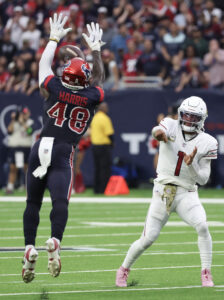
Harris handled over 700 defensive snaps during each of first two seasons in the league. He remained a full-time starter for the 2024 campaign but was limited to just five combined regular and postseason games that year due to a calf injury. The former third-rounder then dealt with an ankle injury during the offseason, but he managed to return to full health in time for training camp.
That resulted in Harris playing in each of Houston’s first four games. During that span, however, the Alabama product saw a snap share of just 13% on defense, a massive drop compared to his other seasons. Harris was a healthy scratch in Week 5. Given his status as a player seemingly not in the team’s immediate plans – coupled with the fact he is attached to the final year of his rookie contract – ESPN’s Jeremy Fowler names Harris as a trade candidate.
Per Fowler, Harris is held in high regard by other teams. That could result in a market being generated with respect to trade interest, especially since he is 24. Harris is attached to a base salary of $3.41MM for 2025; an acquiring team would need to take on a prorated portion of that figure to close out the campaign. Any team willing to trade for him now (as opposed to a free agent pursuit) would presumably look into an extension as well.
After making a notable impact as a rookie, Harris set career highs in tackles (101), sacks (two) and pass deflections (seven) in 2023. Returning to that level of performance would be key in helping his market value, but it appears as though that will not be possible down the stretch if the rest of Houston’s linebacking corps remains healthy. The Texans have Azeez Al-Shaair, Henry To’oTo’o and free agent addition E.J. Speed in place, with each having handled a larger workload than Harris this season. Al-Shaair is under contract for next year, while To’oTo’o will be eligible for an extension this coming spring.
If those two remain key parts in the Texans’ plans for the second level of their defense, moving on from Harris before the November 4 deadline could be a sensible move. Sitting at 2-3 on the year, Houston will presumably avoid a seller’s stance if the team can continue the momentum generated over the past two weeks. Still, Harris will be a player to watch regarding a change of scenery if he continues to serve in a limited capacity leading up to the deadline.
Traded Draft Picks For 2026
Many months remain before teams know where they are picking in the 2026 draft, but many clubs have made moves to acquire 2026 draft capital. Headlined by the Browns, Rams and Cowboys’ efforts, here are the 2026 picks to have changed hands thus far. When more deals involving picks are made (or conditions on moves already completed become known), that information will be added.
Round 1
- Browns hold Jaguars‘ first, after agreeing to move down from No. 2 to No. 5 in swap for WR/CB Travis Hunter
- Rams acquired Falcons‘ top pick, sliding down from No. 26 to 46 in deal that sent OLB James Pearce Jr. to Atlanta
- Cowboys obtained Packers‘ first in trade sending DE Micah Parsons to Green Bay
- Jets added Colts‘ first in trade for CB Sauce Gardner
Round 2
- Texans added Commanders‘ second, obtaining it in four-pick package that re-routed LT Laremy Tunsil to Washington
Round 3
- Eagles picked up Jets‘ third in March 2024 deal that sent OLB Haason Reddick to New York
- Serving as gateway on QB Jaxson Dart‘s New York path (at No. 25 overall), Texans acquired Giants‘ third
- Jaguars hold Lions‘ third due to Detroit climbing 32 spots (to No. 70) for WR Isaac TeSlaa
- Dolphins acquired third from Texans, who moved pick in package for No. 116 (RB Woody Marks)
- Trade for WR George Pickens sent Steelers Cowboys‘ third in deal involving three draft choices between 2026 and ’27
- Dolphins added Eagles third in trade for OLB Jaelan Phillips
Round 4
- October 2024 trade for LT Cam Robinson sent Jaguars conditional fourth-rounder from Vikings
- Chiefs added Bears‘ fourth in swap that sent G Joe Thuney to Chicago
- Patriots snagged selection from Chiefs in deal that gave Kansas City No. 85 (CB Nohl Williams)
- Tunsil trade also sent Texans fourth from Commanders
- Bears snared Rams‘ fourth in deal that gave Los Angeles No. 148 (DL Ty Hamilton)
- Broncos added Saints‘ fourth, sending WR Devaughn Vele to New Orleans
- Raiders obtained higher of Jaguars‘ two fourths in trade involving WR Jakobi Meyers
- Saints acquired Seahawks fourth in trade for WR Rashid Shaheed
Round 5
- August 2024 Ernest Jones trade — the first of the two swaps involving the LB last year — sent Rams pick from Titans
- Titans obtained Rams fifth in trade involving CB Roger McCreary
- In deal that sent G Kenyon Green to Eagles and S C.J. Gardner-Johnson to Texans, Philadelphia obtained Houston’s fifth
- Eagles acquired Falcons fifth by dealing No. 96 to Atlanta (S Xavier Watts)
- Ravens added Jets fifth by moving out of No. 176 (DE Tyler Baron)
- Titans obtained Ravens pick in trade for OLB Dre’Mont Jones
- Pick could upgrade to fourth-rounder
- Titans obtained Ravens pick in trade for OLB Dre’Mont Jones
- Trade for DE Bryce Huff positioned to send Eagles conditional fifth from 49ers
- Pick could upgrade to fourth-rounder based on performance
- Vikings acquired Eagles fifth in trade involving QB Sam Howell
- Browns collected Raiders fifth in trade involving QB Kenny Pickett
- Jaguars obtained Eagles conditional fifth in trade involving RB Tank Bigsby; pick could upgrade to fourth if 49ers DE Bryce Huff meets certain conditions in 2025
- Browns added Bengals fifth in trade for QB Joe Flacco
- Ravens collected Chargers fifth in trade involving OLB Odafe Oweh, S Alohi Gilman
- Shaheed trade sent Saints fifth from Seahawks
Round 6
- Trade involving DL John Franklin-Myers, agreed to on Day 3 of 2024 draft, sent Jets sixth from Broncos
- Vikings acquired Jets sixth in deal involving DL Harrison Phillips
- Eagles added Vikings sixth in trade for Sam Howell
- Ravens obtained Eagles sixth in trade involving CB Jaire Alexander
- Eagles added Vikings sixth in trade for Sam Howell
- Vikings acquired Jets sixth in deal involving DL Harrison Phillips
- Rams obtained pick from Texans in swap that sent WR Ben Skowronek to Houston
- Seahawks added sixth from Browns in deal that sent C Nick Harris back to Cleveland
- Jaguars added pick from Seahawks in October 2024 deal for DL Roy Robertson-Harris
- Intra-NFC East swap involving DT Jordan Phillips brought Giants sixth from Cowboys
- Phillips being on Cowboys’ gameday roster for two games finalized trade
- Intra-AFC East deal for CB Brandon Codrington, Jets received sixth from Bills
- Texans added sixth from Vikings in October 2024 RB Cam Akers swap
- Vikings reacquired choice from Texans in deal for G Ed Ingram
- Pick-swap deal centered around RB Jordan Mason sent sixth to 49ers
- Vikings reacquired choice from Texans in deal for G Ed Ingram
- October trade for DE Josh Uche sent Patriots sixth from Chiefs
- Deadline deal involving OLB Za’Darius Smith gave Browns sixth from Lions
- Bengals obtain Browns sixth in deal for QB Joe Flacco
- Trade involving Gardner-Johnson and Green sent Texans sixth from Eagles
- Lions obtained sixth from Jaguars in pick-swap deal for Isaac TeSlaa
- Trade-up move involving K Tyler Loop (at No. 186) sent Jets sixth from Ravens
- Giants acquired sixth from Dolphins in exchange for retired TE Darren Waller‘s rights
- Texans obtained sixth, TE Harrison Bryant from Eagles in exchange for WR John Metchie, 2025 fifth
- Browns added sixth from Jets, trading DT Jowon Briggs to New York
- Jaguars obtained sixth from Browns in trade involving CBs Tyson Campbell, Greg Newsome
- Raiders added Jaguars sixth in Jakobi Meyers swap
- Jaguars obtained sixth from Browns in trade involving CBs Tyson Campbell, Greg Newsome
- Commanders nabbed 49ers sixth in exchange for RB Brian Robinson
- Vikings collected Colts sixth in deal for CB Mekhi Blackmon
- Tank Bigsby trade sent Jaguars sixth from Eagles
- Titans obtained Jets sixth in trade involving CB Jarvis Brownlee
- Rams added Titans sixth in trade involving CB Roger McCreary
- Patriots netted 49ers sixth in trade involving DE Keion White
- Patriots landed Steelers sixth in trade that sent S Kyle Dugger to Pittsburgh
- Browns acquired sixth from Bears in trade for DE Joe Tryon-Shoyinka
Round 7
- May 2023 trade gave Jaguars conditional seventh from Lions in exchange for K Riley Patterson
- Nick Harris trade sent Browns seventh from Seahawks
- Cowboys added seventh from Giants in Jordan Phillips trade
- Cowboys collected conditional seventh from Chiefs for Peyton Hendershot
- Brandon Codrington trade sent Bills seventh from Jets
- Titans obtained seventh from Chargers in exchange for DB Elijah Molden
- Browns–Bills‘ trade involving WR Amari Cooper sent Cleveland seventh
- Za’Darius Smith pick-swap trade brought Lions seventh from Browns
- Rams acquired seventh from Ravens in Tre’Davious White deadline deal
- Deadline deal involving DT Khalil Davis gave Texans seventh from 49ers
- Jaguars collected seventh from Texans — originally the Rams’ Ben Skowronek pick — in trade for WR Christian Kirk
- Patriots acquired seventh from Saints in deal involving DT Davon Godchaux
- Bills snagged seventh from Cowboys in exchange for CB Kaiir Elam
- In Jowon Briggs trade, Jets added seventh from Browns
- Vikings collected Jets seventh in deal sending DL Harrison Phillips to New York
- Jaguars snared seventh from Eagles in deal sending T Fred Johnson back to Philadelphia
- Browns obtained pick from Jaguars in Greg Newsome trade
- Bears pried pick from Browns in Joe Tryon-Shoyinka swap
- Browns obtained pick from Jaguars in Greg Newsome trade
- Jets added Titans seventh in Jarvis Brownlee trade
- 49ers collected Patriots seventh in pick-swap deal for Keion White
- Steelers acquired Patriots seventh in trade involving Kyle Dugger
- Bengals added seventh from Cowboys in trade involving LB Logan Wilson
Trade Candidate: Jaelan Phillips
While a lot of the focus in Miami right now is on the loss of star wideout Tyreek Hill, the attrition might not stop there. The trade market appears to be hungry for pass rushers, and the Dolphins may just be willing to open one up to the crowd in fifth-year outside linebacker Jaelan Phillips. 
The team’s second first-round pick in 2021, Phillps didn’t have to go far after finishing out his collegiate career at The U. A five-star recruit out of Redlands East Valley HS in southern California, Phillips first committed to play at nearby UCLA. He made an immediate impact as a true freshman before seeing his sophomore season come to an early end after only four games because of a season-ending concussion.
After being dealt multiple other injuries, including some from being hit by a car while on a moped, Phillips followed advice to medically retire from the sport. After the school year ended, though, Phillips transferred to Miami (FL), where he intended to return to football. He sat out the 2019 season, as required by the NCAA transfer rules at that time, before delivering a second-team All-American season for the Hurricanes. He opted to forgo his eligibility and was drafted 18th overall by Miami.
Phillips came swinging out the gate for the Dolphins. Rotating in off the bench most of the time as a rookie, Phillips’ 8.5 sacks were a half-sack away from the team lead, which he did achieve with seven sacks in his sophomore campaign. Over those first two years, in addition to the 15.5 sacks, Phillips compiled 17 tackles for loss, 41 quarterback hits, three pass deflections, three fumble recoveries, and a forced fumble.
In 2023, Phillips looked to be on pace for career-defining year. After missing three of the team’s first five games, he went on a six-game tear. In eight games total, Phillips had racked up 6.5 sacks and seven tackles for loss. With six games left in the season, Phillips looked certain to achieve some new career highs. Instead, a torn Achilles tendon ended his season.
The Dolphins exercised Phillips’ fifth-year option, giving themselves a bit more time to see how he might recover and rejoin the team, and he worked hard to make his way back to the field in time for some training camp. He had overcome injury again and was ready to reap his reward. Unfortunately, Phillips’ injury troubles did not stay at bay for long. In just the fourth week of the 2024 season, Phillips suffered a partially torn ACL that would end that season, as well.
 After three and a half healthy seasons of high-level play, it seemed as if Phillips had beaten his injury demons, coming back from the brink of football retirement to become a first-round pick and an NFL starter. In the past two years, though, the medical red flags from his past have begun to stick again.
After three and a half healthy seasons of high-level play, it seemed as if Phillips had beaten his injury demons, coming back from the brink of football retirement to become a first-round pick and an NFL starter. In the past two years, though, the medical red flags from his past have begun to stick again.
Still, Phillips is healthy today. Once again working his way back to the field for the start of the regular season, Phillips has started every game so far for Miami and hasn’t appeared on a single injury report. He hasn’t amassed a sack, tackle for loss, or quarterback hit this year, but the Dolphins have been slow to work him back up to the volume of snaps he was playing back in 2022.
If a team is willing to give up some draft compensation for a partial-year rental of Phillips, it seems Miami would be more than willing to oblige. With Phillips on the final year of his contract, there’s a chance he could earn a lucrative deal in free agency if the team that trades for him doesn’t extend or re-sign him. If so, that team could potentially earn a compensatory pick for losing him.
The Dolphins, too, could just wait for the compensatory reward of letting Phillips walk in free agency, but according to Greg Auman of FOX Sports, Miami would prefer to get a pick for the 2026 NFL Draft now rather than wait for the comp pick in 2027. Plus, because of the comp pick potential, they can ask for a bit more in draft compensation, though it may be a wash as the team receiving him would be taking on more than half of the $13.25MM base salary he’s due this year on his fifth-year option.
So, what teams might be interested in acquiring the 26-year-old with a bit of an injury history? It would likely be a team that is struggling to get pressure on opposing quarterbacks, and knowing the short-term nature of his deal, they could be hoping to contend this year. The 49ers fit that bill, considering their 18 pressures are good for second-worst in the NFL, despite the fact that they are one of only two teams to have played five games this year. The Commanders, Chiefs, and Eagles are also playoff-hopeful teams who currently sport middle-of-the-road pass rush numbers.
Regardless, there may not be much of a future for Phillips in Miami. Even if he could work his way past a slow start and finish the season strong, his brutal injury history may dissuade a Dolphins front office that has already watched him miss a good portion of the last two seasons. Counterintuitively, a brighter future for Phillips may await him outside of Miami.
Free Agent Stock Watch: Travis Etienne
Regime change has been a common occurrence during Travis Etienne‘s Jacksonville tenure. Although only two GMs have been in place during the former first-round pick’s time in Duval County, the team has effectively gone through three power structures during the RB’s five-season run.
The coach who drafted Etienne (Urban Meyer) proved unfit for NFL leadership but held full personnel control during his eventful several months on the job. Meyer had shown interesting transparency on the night the Jaguars chose Etienne, indicating the team wanted Kadarius Toney with the second of its first-round picks that night. GM Trent Baalke took over as the lead personnel exec following Meyer’s ouster, but Shad Khan fired him as the unpopular exec had affected the team’s 2025 HC search. The James Gladstone–Liam Coen power structure now controls Etienne’s future — until March, that is.
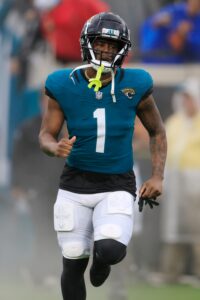 After a down 2024 during a disastrous Baalke-Doug Pederson finale, Etienne looked like he was fading out of the picture this offseason. Trade rumors emerged, with the Clemson alum’s fit in Coen’s offense questioned, and the Jags added two Gladstone-tabbed draftees (Bhayshul Tuten, LeQuint Allen) at the position. Those two crowded the backfield, after Tank Bigsby had forced a timeshare with Etienne last season. But Bigsby ended up being the one moved. This has smoothed Etienne’s runway to impress in a contract year.
After a down 2024 during a disastrous Baalke-Doug Pederson finale, Etienne looked like he was fading out of the picture this offseason. Trade rumors emerged, with the Clemson alum’s fit in Coen’s offense questioned, and the Jags added two Gladstone-tabbed draftees (Bhayshul Tuten, LeQuint Allen) at the position. Those two crowded the backfield, after Tank Bigsby had forced a timeshare with Etienne last season. But Bigsby ended up being the one moved. This has smoothed Etienne’s runway to impress in a contract year.
Entering Week 5, Etienne leads the NFL with 6.1 yards per carry. His 394 rushing yards rank trail only Jonathan Taylor and James Cook this season. Both Cook and Taylor entered the season entrenched as their teams’ starting running backs. The Tuten-Allen draft class and Bigsby’s presence clouded Etienne’s Jacksonville future, but a 143-yard opener — highlighted by a 71-yard run — showed the potential for a contract-year bounce-back effort.
The Jags traded Bigsby to the Eagles for fifth- and sixth-round picks days later, and Etienne has regained his role as the backfield leader. Etienne also posted a 100-yard rushing performance against the 49ers, giving the Jags a road upset over a team with a high-level defense. We are only at the quarter pole for the season, but Etienne’s free agency value has increased based on his start and return to surefire RB1 duty in Jacksonville.
The ex-Trevor Lawrence college teammate had held this position in 2022 and ’23, submitting back-to-back 1,000-yard seasons after missing his rookie year with a Lisfranc injury. A costly fumble at the goal line during a narrow Week 1 loss to the Dolphins proved a harbinger of a step backward last year, however, as Etienne stumbled to a 558-yard season in 15 games. Bigsby also outgained him by a wide margin, tallying 766 yards. The landscape looks different for Etienne post-Bigsby, and the 2026 free agent market also lost some key names this summer.
Both Cook and Kyren Williams signed extensions, moving two 2022 draftees out of the free agent picture. Etienne became grouped with the 2022 draft class due to the Jags picking up his fifth-year option — an affordable $6.14MM — in May 2024. The rest of the 2021 RB class has already moved onto second contracts. The other first-round RB that year, Najee Harris, saw his fifth-year option declined and joined the Chargers in free agency. The Patriots and Panthers respectively extended Rhamondre Stevenson and Chuba Hubbard on similar deals — pacts that certainly could be relevant for Etienne.
The New England and Carolina RBs are tied to $9MM- and $8.3MM-per-year extensions, respectively. The contracts check in outside the top 10 in RB AAV. Etienne will need to stick the landing on this turnaround campaign if he is to move toward the Cook-Williams level; the Bills and Rams gave their respective starters $11MM- and $11.5MM-AAV extensions. Another sizable cap increase would help the five-year Jaguar’s cause, but matching the Cook and Williams numbers might be overly optimistic for a player whose value has fluctuated.
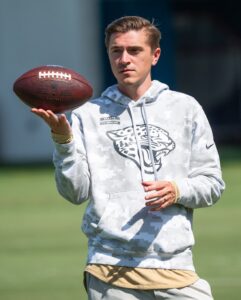 Etienne having a better resume compared unsigned 2022 draftees Breece Hall and Kenneth Walker could make him the top RB available next year, but age also stands to be a factor for the Jags ballcarrier. Hall is in an age-24 season, while Walker will turn 25 this month. Because Etienne both surprised by staying at Clemson for his 2020 senior season and was then restricted by the fifth-year option, he will be 27 when free agency opens. That is certainly on the older end for a first-time RB UFA.
Etienne having a better resume compared unsigned 2022 draftees Breece Hall and Kenneth Walker could make him the top RB available next year, but age also stands to be a factor for the Jags ballcarrier. Hall is in an age-24 season, while Walker will turn 25 this month. Because Etienne both surprised by staying at Clemson for his 2020 senior season and was then restricted by the fifth-year option, he will be 27 when free agency opens. That is certainly on the older end for a first-time RB UFA.
Among RBs, only Etienne and Saquon Barkley have seen their fifth-year options exercised over the past seven offseasons. The Giants delayed Barkley’s path to free agency by franchise-tagging him after that option year, and the team did not show interest in re-signing him due partially to age. Barkley proceeded to deliver an all-time RB season in Philly, though the gulf in talent between he and Etienne (or he and just about every active running back) is fairly wide. Still, Etienne staying healthy should create a decent market — especially if he stays on this track.
A 2026 tag would seem a bit pricey here, with OverTheCap projecting the RB figure to come in beyond $14MM. The Jags also have Tuten as a potential replacement for 2026, with Allen as a passing-down option as well.
Etienne could force the new regime’s hand by continuing a strong season, with the current power brokers clearing out the veteran skill-position contracts (Evan Engram, Christian Kirk, Gabe Davis, Devin Duvernay) on the payroll this offseason. But as it stands entering October, Etienne is pointed toward a 2026 Jacksonville exit. The Jags hold exclusive negotiating rights with their RB1 until the legal tampering period begins March 9, but this will be an interesting market to monitor in the coming months.
Poll: Which 0-3 Team Has Best Chance Of Reaching Playoffs?
Six teams currently find themselves at 0-3 to begin the year. Managing to rebound from that mark and reach the playoffs has proven to be an extremely difficult task over the years. 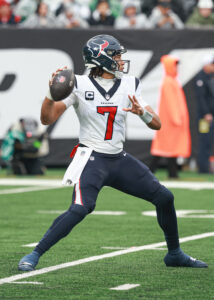
Only four times has a team reached the postseason after starting 0-3 since 1990. Crucially, none have achieved the feat since the playoffs were expanded from six to seven teams in each conference in 2021. Whether or not that continues this season will be interesting to see.
Chances are slim for any of the league’s winless teams to rally into the postseason, but there is of course variance with respect to their prospects of doing so. There is an argument to be made the Texans represent the likeliest candidate to pull off such a comeback, based largely on their defensive success to date. Houston ranks fifth in the NFL in points allowed (17 per game on average) and the team’s losses have come by a combined margin of 13 points.
Improvement on offense could thus help turn things around in short order, but the Texans’ offseason renovations up front have not gone as planned so far. Third-year quarterback C.J. Stroud has not been able to return to the form shown during his stellar rookie campaign, and a number of new pass-catchers are in the process of acclimating to an offense lacking a strong ground game. Catching the undefeated Colts for top spot in the AFC South would be a surprise at this point, but a wild-card berth could very much still be within reach if Nick Caley‘s unit can turn things around.
 Houston will take on the Titans in Week 4 in a clash of teams seeking their first win. Tennessee entered the year with far lower expectations, but the team’s performance to date has still left plenty to be desired. The Titans lead the league in penalties (31) and rookie quarterback Cam Ward has been sacked an NFL-high 15 times. Second-year head coach Brian Callahan sports a record of 3-17 at this point, and it remains to be seen if he will be entrusted with overseeing Ward’s development over the long term.
Houston will take on the Titans in Week 4 in a clash of teams seeking their first win. Tennessee entered the year with far lower expectations, but the team’s performance to date has still left plenty to be desired. The Titans lead the league in penalties (31) and rookie quarterback Cam Ward has been sacked an NFL-high 15 times. Second-year head coach Brian Callahan sports a record of 3-17 at this point, and it remains to be seen if he will be entrusted with overseeing Ward’s development over the long term.
Callahan relinquished offensive play-calling duties this week, and he will now look to increase his involvement in other aspects of the team. Finding success in that regard would no doubt help his job security. It would also, presumably, allow for Tennessee to improve on last season’s 3-14 showing and offer signs of progress from Ward and a supporting cast in need of improvements moving forward.
Another intra-divisional Week 4 game will see the Dolphins take on the Jets. The first half of the upcoming Monday Night Football doubleheader will be key in determining both teams’ immediate futures. Miami was seen as a disappointment given how the 2024 campaign played out. Head coach Mike McDaniel has certainly not helped his standing in the organization so far this season, although a concerted effort to improve the Dolphins’ culture could help stave off a firing for he and general manager Chris Grier. 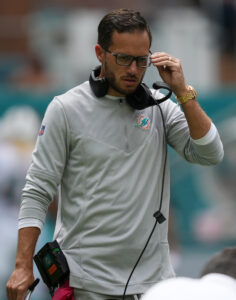
Finding a rhythm on offense has proven to be highly challenging in 2025, even with quarterback Tua Tagovailoa managing to avoid any injuries to date. Stronger play on both sides of the ball will be needed if Miami is to reach the playoffs for the third time in McDaniel’s fourth season at the helm. Winning a postseason contest will become a major objective in that event, but for now quieting the rumors about major organizational changes will be the goal.
By contrast, 2025 marks another new beginning for the Jets. Rookie head coach Aaron Glenn and first-year general manager Darren Mougey are seeking to provide the team with long-term stability in addition to ending a playoff drought which dates back to 2010. That effort has not gone according to plan so far, but a key element will be the evaluation of new quarterback Justin Fields. The former first-rounder is back at practice, and he will return to starting duties upon being cleared from concussion protocol.
 Fields is under contract through 2026, but helping lead the Jets to the playoffs would greatly increase his chances of landing a long-term accord. It would also help Glenn and Mougey’s standing, although at this point their job securities are of course not in question. Still, a strong first campaign in New York (something which could be attained without a postseason berth, at least in theory) would be welcomed by the duo; a quick rebound from the way things have started would suffice, and it would be less surprising than one from some of the league’s other winless outfits.
Fields is under contract through 2026, but helping lead the Jets to the playoffs would greatly increase his chances of landing a long-term accord. It would also help Glenn and Mougey’s standing, although at this point their job securities are of course not in question. Still, a strong first campaign in New York (something which could be attained without a postseason berth, at least in theory) would be welcomed by the duo; a quick rebound from the way things have started would suffice, and it would be less surprising than one from some of the league’s other winless outfits.
New York’s NFC squad is in a state of flux in no small part due to another unwanted beginning to a campaign. Giants head coach Brian Daboll and general manager Joe Schoen managed to remain in place this offseason, but aside from a high-scoring output against the Cowboys things have not gone according to plan. The decision has been made to replace quarterback Russell Wilson with first-round rookie Jaxson Dart, and the outcome of that move (beginning with a debut against the 3-0 Chargers) will be critical on a number of fronts. 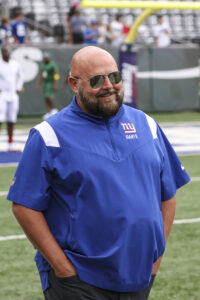
Daboll and Schoen are known to be on the hot seat, and showing potential for a turnaround with Dart in place would go a long way in helping ensure they remain in place. Owner John Mara made clear his mandate for a step forward compared to 2024 (3-14), and plenty of work remains given how things have gone early in the current campaign. If the Giants are to at least contend for a wild-card spot this season, Dart will no doubt be a key figure in the process.
Joining the Jets as a team led by a rookie head coach encountering early struggles are the Saints. New Orleans underwent a number of offseason changes, with Kellen Moore‘s hire being the most noteworthy. The longtime NFL OC was a central figure in the decision to draft Tyler Shough, but instead of the second-rounder handling starting duties it has been Spencer Rattler at the helm so far.
 The Saints’ QB setup raised eyebrows amongst some of their players, but Rattler has improved upon his output from last season’s late spell in the starter’s role. Two of New Orleans’ losses, meanwhile, came about in one-score games. A postseason berth was not expected from the team, with many pointing to the 2026 draft as the point where a new franchise quarterback would arrive. Rattler (or potentially Shough, depending on how things play out) could earn an extended look in the QB1 role, however. A quick recovery toward postseason contention would come as a surprise, but at a minimum a bounce-back from last week’s lopsided loss in Seattle will be sought out. Doing so against the undefeated Bills will of course be a tall task.
The Saints’ QB setup raised eyebrows amongst some of their players, but Rattler has improved upon his output from last season’s late spell in the starter’s role. Two of New Orleans’ losses, meanwhile, came about in one-score games. A postseason berth was not expected from the team, with many pointing to the 2026 draft as the point where a new franchise quarterback would arrive. Rattler (or potentially Shough, depending on how things play out) could earn an extended look in the QB1 role, however. A quick recovery toward postseason contention would come as a surprise, but at a minimum a bounce-back from last week’s lopsided loss in Seattle will be sought out. Doing so against the undefeated Bills will of course be a tall task.
Only once since 1990 has a team started 0-4 but managed to reach the playoffs. By contrast, moving to 1-3 has been more beneficial (with 35 teams doing so in that same span). The success of this year’s group in recording a first win this weekend and generating momentum beyond that point will make for an interesting storyline.
Out of this group of winless teams, which do you feel will have the best chance of rebounding and qualifying for the postseason in 2025? Vote in PFR’s latest poll and have your say in the comments section below.
2025 Offseason In Review Series
Here are PFR’s breakdowns of each NFL team’s 2025 offseason.
AFC East
AFC North
AFC South
AFC West
NFC East
NFC North
NFC South
NFC West
Offseason In Review: Cleveland Browns
It had been a while since the Browns had felt the lows felt in 2024. Since Cleveland drafted Baker Mayfield No. 1 overall in 2018, the team had either hovered around .500 or made the playoffs in every season. After one such playoff berth in 2023, an effort at back-to-back winning seasons for the first time since 1988 and ’89 produced a 3-14 campaign and brought Cleveland crashing back to Earth. Continued struggles and injury issues for Deshaun Watson and a trio of backup quarterbacks resulted in the league’s lowest-scoring offense and lowest win total.
Kevin Stefanski hasn’t, somehow shockingly, become the NFL’s ninth-longest-tenured head coach for no reason, though. Following a season of turmoil, change was a certainty. So many contradictory headlines flew out of Cleveland this offseason concerning so many different, important decisions — such as the future of the team’s defensive MVP or its four-way battle under center — that anything became possible. Fans won’t end up caring much about how many statements general manager Andrew Berry and Co. walked back, as long as the moves made this offseason lay a path forward for success.
Extensions and restructures:
- Agreed to four-year, $160MM extension ($88.8MM guaranteed) with DE Myles Garrett
- Restructured QB Deshaun Watson‘s contract, freeing up $36.8MM of cap space
- Removed year from RT Jack Conklin‘s deal to create nearly $7MM in cap space
- Restructured G Joel Bitonio‘s deal to open up $2.4MM of cap room
- RB Jerome Ford took pay cut, clearing $1.7MM in cap space
Closing in on the final weeks of the franchise’s worst season since the winless 2017, one of several large stories in Cleveland’s offseason began as the team’s defensive star questioned its long-term plan. Seeking answers from the top brass on how they would dig themselves out of this hole, Garrett dangled the threat of a trade request that would set the stage for the two-month saga.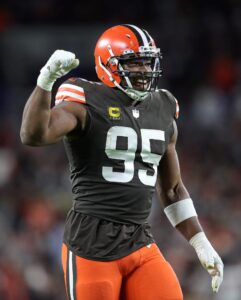
Berry tried to calm the waters, assuring fans he had no plans on trading the former No. 1 overall pick and that his expectations were for Garrett to eventually retire a Brown. A conversation between the two seemed to build some goodwill, with Garrett coming away from the meeting posing the issue of how they might best capitalize on all the talent surrounding him on the team right then.
Part of Garrett’s concern also centered on him having outplayed the five-year, $125MM contract he had signed in 2020. The threat of a trade request began to shift from concern for team success to concern for a new contract. With two years remaining on the four-time first-team All-Pro’s deal, Berry had to judiciously tell the media something was in the works without promising a new contract, at the same time continuing to assure fans that he did not intend to trade Garrett.
At that point, Garrett abandoned any pretense about team success and requested a trade, asserting that an aggressive offseason from the front office would no longer do anything to quell his trade interest. Not a day later, teams were calling. Offers including more than a first-round pick were rumored as part of a would-be blockbuster.
Realizing Josh Sweat was likely to price himself out of Philadelphia, the reigning champs had Garrett on their radar. While the Eagles’ interest was very real, Buffalo, too, was having visions of pairing Garrett with young pass rusher Greg Rousseau as an upgrade over an aging Von Miller. But the Browns did not relent on their intent to retain the future Hall of Fame edge rusher.
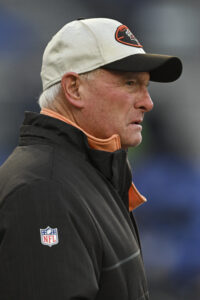 Garrett consulted with basketball star LeBron James — someone quite famous for his own dramatic departure from Cleveland — and saw teammate Denzel Ward throw in his support with a similar questioning of his own future with the team. Cleveland’s front office was scrambling to figure out an offer, but Garrett had landed on a decision that he was no longer open to an extension.
Garrett consulted with basketball star LeBron James — someone quite famous for his own dramatic departure from Cleveland — and saw teammate Denzel Ward throw in his support with a similar questioning of his own future with the team. Cleveland’s front office was scrambling to figure out an offer, but Garrett had landed on a decision that he was no longer open to an extension.
Multiple executives from around the league became convinced that the drama had to end in a trade, but at the Combine — a popular place for team decision-makers to have unofficial conversations — no negotiations were entertained by Cleveland. In fact, when Garrett requested to meet with Jimmy Haslam to facilitate a change of scenery, the 71-year-old owner declined the meeting, seemingly putting the saga at an impasse.
If one thing can help someone forget all the reasons they said they wanted to leave, though, it’s a four-year, $160MM extension with $123.5MM guaranteed in total. It’s unclear how discussions continued, how the offer was delivered, what the Browns promised they would do to change the outlook of their franchise; regardless, Garrett insisted that his eyes were opened, his confidence in the team’s plan had changed for the better, and it had nothing to do with money.
Speaking of money, despite holding an NFL second-best $41.95MM of salary cap carryover from 2024 and seeing yet another large salary cap increase, Cleveland entered the offseason $30.17MM over the cap for 2025. The figure was the second-worst in the league, with only the perpetually cap-strapped Saints in bigger trouble. The Browns had a few options to get to a better area cap-wise; again reducing an albatross cap number became the most obvious place to start.
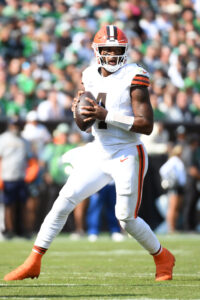 Watson had suffered a setback on his road to recovery from a torn Achilles, as a second tear of that tendon occurred. The Browns went to the Watson restructure well again, continuing to lower record-setting cap hits on the QB’s fully guaranteed deal. This one converted $44.7MM of base salary into a signing bonus and added a third void year to the end of his contract. Even after taking $36.8MM off his cap hit, Watson’s $35.97MM figure in 2025 sits as the 12th-highest in the NFL.
Watson had suffered a setback on his road to recovery from a torn Achilles, as a second tear of that tendon occurred. The Browns went to the Watson restructure well again, continuing to lower record-setting cap hits on the QB’s fully guaranteed deal. This one converted $44.7MM of base salary into a signing bonus and added a third void year to the end of his contract. Even after taking $36.8MM off his cap hit, Watson’s $35.97MM figure in 2025 sits as the 12th-highest in the NFL.
The Browns also put in an insurance claim that could net a further credit to their cap sheet based on the injuries occurring within a time frame set up in a contractual addendum; they received credit off a $13.9MM portion of Watson’s salary in 2024, and the credit for 2025 would be based off a portion of Watson’s original $46MM salary for the year.
An additional $7MM of cap relief came from allowing Conklin to reach free agency at the end of this season, a year earlier than intended. Conklin’s reworked agreement gave him a $10MM 2025 salary with $9MM guaranteed. $2MM of potential incentives could slightly take away from his cap relief, retroactively.
The Browns’ longest-tenured player, Bitonio decided to play another season after briefly considering retirement. The 12th-year guard signed a restructured deal that converted a $3MM roster bonus into a signing bonus and added $600K to each of the four void years following the expiration of his contract.
Notable losses:
- Jordan Akins, TE
- Nick Chubb, RB
- Michael Dunn, OL
- Mike Ford, CB
- D’Onta Foreman, RB
- Nick Harris, C
- Jordan Hicks, LB (retired)
- James Hudson, T
- Charley Hughlett, LS (released)
- Germain Ifedi, T
- Rodney McLeod, S
- Elijah Moore, WR
- Ogbo Okoronkwo, DE (released)
- James Proche, WR
- Juan Thornhill, S (post-June 1 cut)
- Dalvin Tomlinson, DT (post-June 1 cut)
- Jedrick Wills, T
- Jameis Winston, QB
- Bailey Zappe, QB
Another way the Browns figured they could shed some unwanted cap hits was with a series of strategic cuts. By designating the releases of Thornhill and Tomlinson as post-June 1 cuts, the team was able to open up nearly $10MM of cap space. Thornhill was set to hold a $5.68MM charge on the books; his release provided the team with $3.4MM of relief. Tomlinson would have represented $17.15MM in dead cap had he been released without the designation; with it, the team saved $6.41MM of cap space.
 Similarly, the release of Okoronkwo resulted in $3.67MM of cap savings, while a heartfelt goodbye to Hughlett opened up $1.08MM more. The Browns had tried shopping Okoronkwo in an attempt at cap relief and perhaps a bit of compensation in return, but the 30-year-old had already been designated as a cut candidate — alongside defensive tackle Shelby Harris, who remained on the team in lieu of $1.68MM of cap relief — and ended up being cut as expected.
Similarly, the release of Okoronkwo resulted in $3.67MM of cap savings, while a heartfelt goodbye to Hughlett opened up $1.08MM more. The Browns had tried shopping Okoronkwo in an attempt at cap relief and perhaps a bit of compensation in return, but the 30-year-old had already been designated as a cut candidate — alongside defensive tackle Shelby Harris, who remained on the team in lieu of $1.68MM of cap relief — and ended up being cut as expected.
Part of the solution to the team’s quarterback issues in 2024, Winston expressed desires of re-signing. With hopes of creating a better quarterback situation for the future, the Browns opted not to pursue another contract with Winston.
Chubb, too, expressed a desire to stay in Cleveland in the early days of the offseason, but there were no immediate plans for the team to re-sign the four-time Pro Bowler. By May, Chubb remained unsigned, and though Berry wouldn’t rule anything out, there was still little likelihood that Chubb would end up with a new Browns contract. In the days before the draft, there were a few internal discussions about a possible return, but a decision was clearly made that resulted, instead, in the team drafting two rookie backs.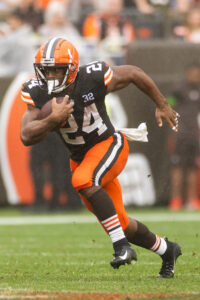
The loss of Moore is an interesting one because the Browns placed a UFA tender on him before he signed a deal with the Bills. Buffalo swooped in in plenty of time to prevent Cleveland from getting exclusive negotiating rights, but the Browns will now await some level of compensatory draft pick compensation depending on how Moore performs in 2025. Everybody ends up a winner here as the Browns get their pick, Moore’s potential earnings of $5MM end up being more than his tendered salary of $3.43MM would’ve been, and the Bills add another weapon for reigning MVP Josh Allen.
Wills’ tenure with the Browns ended in a bit of a whimper. The No. 10 overall pick for the team in 2020, the hopeful left tackle of the future had missed 21 games over the past two seasons as injuries began to define his career. With news that he will continue to miss time into the 2025 season, the Browns have moved on, but other teams appear to have shown interest.
Free agency additions:
- Maliek Collins, DT: Two years, $20MM ($13MM guaranteed)
- Joe Tryon-Shoyinka, DE: One year, $4.76MM ($3.48MM guaranteed)
- Cornelius Lucas, T: Two years, $6.5MM ($3.26MM guaranteed)
- Joe Flacco, QB: One year, $4.25MM ($3MM guaranteed)
- Teven Jenkins, OL: One year, $3.05MM ($2.67MM guaranteed)
- Rayshawn Jenkins, S: One year, $1.42MM ($1.17MM guaranteed)
- Damontae Kazee, S: One year, $1.42MM ($1MM guaranteed)
- DeAndre Carter, WR: One year, $1.42MM ($768K guaranteed)
- Jerome Baker, LB: One year, $1.42MM ($718K guaranteed)
- Julian Okwara, LB: Practice squad
After clearing cap space, the Browns were in a better spot but not quite in a place to enter bidding wars over star free agents. Per OvertheCap, Cleveland spent the least amount of money in free agency this year and was one of only four teams to sign 10 or fewer new free agent deals over the veteran minimum.
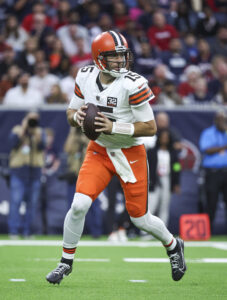 That doesn’t mean that free agency wasn’t interesting. It was, of course, one of several avenues the team explored in order to fill its quarterbacks room.
That doesn’t mean that free agency wasn’t interesting. It was, of course, one of several avenues the team explored in order to fill its quarterbacks room.
With a number of veteran passers owning Super Bowl experience on the market, Cleveland set a meeting with Russell Wilson and expressed interest in Flacco and Carson Wentz. Though the team appeared serious about pursuing Wilson, its lack of interest in a long-term deal with the 36-year-old hurt its chances of landing his signature. One veteran option fell off the table when Winston tired of waiting for a Browns offer and signed with the Giants, just for Wilson to follow suit four days later.
Falcons passer Kirk Cousins worked to find his way out of Atlanta this offseason, and the Browns were, once again, linked as a suitor. Unable to secure his release, Cousins looked to find a trade partner after the draft. Cousins’ name in connection to Cleveland (and a reunion with Kevin Stefanski) would surge one last time a day before the draft, but Cousins ended up resigning to his fate in Atlanta as the NFL’s most expensive backup quarterback.

